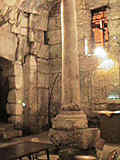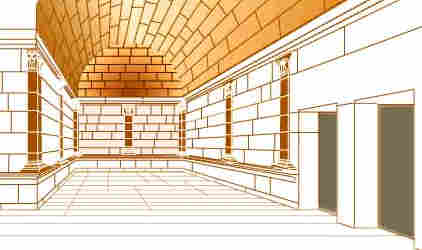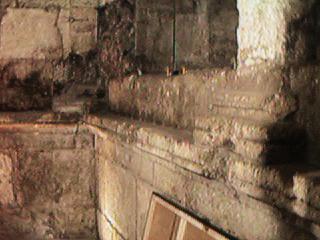
Western Wall Tunnel Tour ©

Here, close to Wilson's Arch, is the "Hall of the Hasmoneans." It was "discovered" by Charles Warren during his excavation work in the late 1860s. Impressed by its beauty, Warren named the room the "Hall of the Freemasons."
The room includes a number of distinctive features:
- The decorative molding
- The central pillar
- A mikveh (ritual bath)
- Ballisticae
- The double door
For a fuller view of how the room may have looked, enjoy
the following picture. 
Was this a Chamber of the Council Building, mentioned by
Josephus? Archaeologists believe that this building was used much earlier, during the
reign of the Hasmoneans, for some public function. This is one of
the few remains of the magnificent buildings from the Second Temple Period. 
The hall is part of a group of buildings from the Second
Temple era, which are located next to the Temple Mount. Take a moment to appreciate the
beauty and grandeur, and the room's unique dressed stones. Such
craftsmanship is the mark of the Herodian period. If you look a little closer, you can see
the decorative cornice and the capitals that originally
ran all around the room. 
In the center of the room, you'll see a Corinthian pillar. During the Middle Ages the full pillar was brought into the room to support the ceiling, which had been damaged during the course of time and needed support. Go back to "Features"
We also see a Mikveh, which was supplied with water from an subterranean spring. Some feel the presence of the Mikveh indicates that the room may have been used by the Cohanim as part of their performace of the Temple service. Go back to "Features"
Ever wonder what the ancients used for ballistic missiles?
That's right, ballisticae!  Right
in this room, you'll find a number of ballisticae that were launched by the Romans during
their attack on Jerusalem in 70 C.E., and later against the Bar Kochba rebellion in 132
C.E. Go back to "Features"
Right
in this room, you'll find a number of ballisticae that were launched by the Romans during
their attack on Jerusalem in 70 C.E., and later against the Bar Kochba rebellion in 132
C.E. Go back to "Features"
Fortunately for us, the damage at that time was small, and today, almost 2,000 years later, we are back, actively reconnecting to our precious past. And instead of the Jewish people, it is the Romans who have been buried in the sand dunes of history.
You glance one more time around the room, aware of the dim
lighting,  the cool air, almost able to conjure up a vision of the people of those
times. What did they do here? Why did they come? Your mind races through a hundred images.
the cool air, almost able to conjure up a vision of the people of those
times. What did they do here? Why did they come? Your mind races through a hundred images.
Could it be that these rooms were opened to ordinary Jews? Perhaps they were used as places where the public could eat from the offerings they would bring to the Temple, almost like an ancient picnic area or bar-b-cue! Maybe we are not so distant from our ancient brethren after all...
You can easily see the vision of a family, the father, the mother, the pack of kids and animals, coming to the Temple from miles and miles away, coming for Pesach, Shavuos or Succos. They would bring a peace offering and include some of the meat from that offering in their festive meal. Where would they eat? Perhaps right here, in this room. Yes, it could have been like that...and now you are here.
Of course, the offerings and the life of the Temple are enough to fill their own tour. For now, though, we'll leave this room and turn back until we come upon a large chamber with four wings.
| Jewish Calendar Date |
SECOND
TEMPLE TIMELINE |
||
| 3400 | |||
| 352 BCE: Construction of the Second Temple | |||
| 347 BCE: Return to Israel of Ezra and the Men of the Great Assembly | |||
| 312 BCE: Era of the Prophets ends; Alexander the Great conquers Darius of Persia; Shimon HaTzaddik (First Tanna) meets Alexander | |||
| 3450 | |||
| 3500 | |||
| 260 BCE: Period of "Pairs" begins | |||
| 245 BCE: Ptolemy; Translation of the Torah into Greek (Septuagint) | |||
| 3550 | |||
| 175 BCE: Antiochus IV; Beginning of the Greek oppression of Israel | |||
| 165 BCE: Miracle of Chanukah; Kingdom of Hasmoneans begins; Start of the Period of the Saduccees and the Pharisees | |||
| 3600 | |||
| 3650 | |||
| 3700 | |||
| 36 BCE: Herod defeats Antignos, ends
Hasmonean Dynasty, and begins his rule 32 BCE: Leadership of Hillel begins |
|||
| 18 BCE: Herod begins Temple Reconstruction | |||
| 3750 | |||
| 3800 | |||
| 70 CE: Second Temple Destroyed by Titus; Roman Rule of Israel established 73 CE: Fall of Massada | |||
| 80 CE: Rabbi Akiva's leadership begins | |||
| 3850 | |||
| 93 CE: Josephus completes writing "Jewish Antiquities" | |||
| 135 CE: Rebellion of Bar Kochba | |||
| 3900 | |||
| 3950 | |||
| 219 CE: Mishnah compiled by Rabbi Yehuda HaNassi; Period of Amorayim begins | |||
| 4000 | |||
| 4050 | |||
| 306 CE: Constantine the Great begins his rule; Christianity becomes religion of Roman Empire | |||
| 4100 | |||
| 352 CE: Byzantine of Constantinople; under Constantine, conquer Israel | |||
| 4400 | |||


